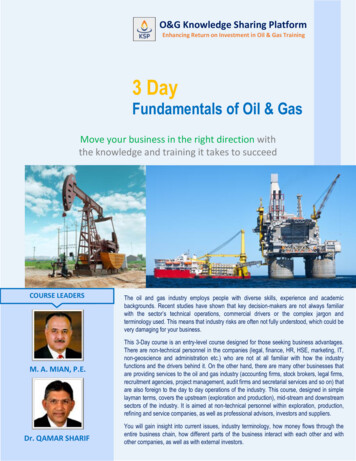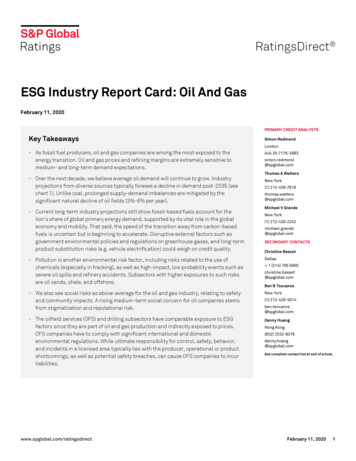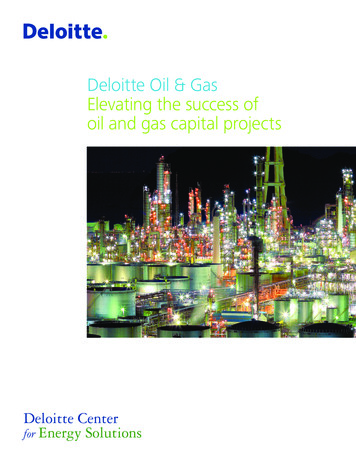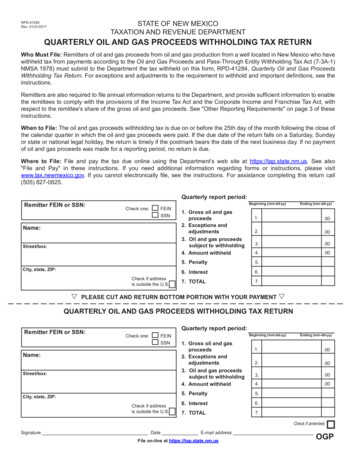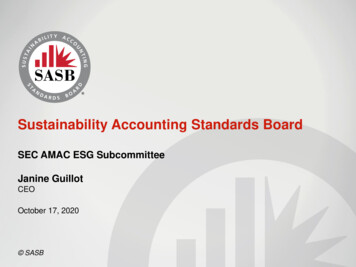
Transcription
MUMBAISI LI C O N VALLE YBAN G A LO RESI N G A P O REMUMBAI BKCNEW DELHIMUNICHNE W YO RKOil & Gas Industryin IndiaLegal, Regulatory and TaxFebruary 2018 Copyright 2018 Nishith Desai Associateswww.nishithdesai.com
Oil & Gas Industry in IndiaLegal, Regulatory and TaxFebruary 2018ndaconnect@nishithdesai.com Nishith Desai Associates 2018
Oil & Gas Industry in IndiaLegal, Regulatory and TaxContents1.INTRODUCTION012.INDUSTRY AT A GLANCE03I.II.III.030304ImportExportMajor Industry Players3.RECENT INITIATIVES BY THE GOVERNMENT OF INDIA054.FOREIGN INVESTMENT065.REGULATORY AND LEGAL FRAMEWORK076.THE DISCOVERED SMALL FIELDS POLICY AND BIDDING ROUND13I.II.13137.8.OverviewSalient Features of Discovered Small Fields PolicyHYDROCARBON EXPLORATION AND LICENSING POLICY rm LicenseRevenue Sharing ModelMarketing and Pricing Freedom for Crude Oil and Natural GasOpen Acreage PolicyOther ChangesHYDROCARBON EXPLORATION & LICENSING POLICY (HELP)OPEN ACREAGE LICENSING POLICY (OALP) BID ROUND – 116I.The Bidding Process16DISPUTE RESOLUTION20I.II.ArbitrationLitigation202110. CONCLUSION229. Nishith Desai Associates 2018
Oil & Gas Industry in IndiaLegal, Regulatory and Tax1. IntroductionIndia is one of the fastest growing majoreconomies in the world and the third largestconsumer of petroleum products, after US andChina.1 Although there is an increased focuson gas and renewables, demand for oil hasalways been on the rise, and is estimated to growat least until 2040.2 As per the report publishedby India Brand Equity Foundation (IBEF)3,India’s energy demand is expected to double to1,516 million tonnes of oil equivalent (Mtoe) by2035 from 723.9 Mtoe in 2016. Moreover, India’sshare in global primary energy consumption isprojected to increase by two-folds by 2035.Natural Gas (“O&NG”) sector. India’s domesticcrude oil production of 36.95 million tonnesin 2015-16 barely met 20 percent of its oilneeds. Natural gas output at 32.249 billioncubic meters meets less than half of its needs.5As a result of significant dependence onimport, Prime Minister Narendra Modi hasset a target to reduce dependence on crudeimports by 10% by 2022.India’s total oil imports rose 4.24 percent yearon-year to US 86.45 billion in 2016-17. India’soil consumption grew 8.3 percent year-on-yearto 212.7 million tonnes in 2016, as against theglobal growth of 1.5 percent, thereby makingit the third-largest oil consuming nation inthe world. India is the fourth-largest LiquefiedNatural Gas (LNG) importer after Japan, SouthKorea and China, and accounts for 5.8 percentof the total global trade.4In India, the O&NG industry has huge potentialand contributes over 15% to the India’s GDP.The landscape in the O&NG sector promises tobe dynamic with scope for growth of businessentities. This industry has always attractedforeign direct investments, and according todata released by the Department of IndustrialPolicy and Promotion (DIPP), the petroleum andnatural gas sector attracted FDI worth US 6.86billion between April 2000 and September 2017.6With 3.14 million sq. km of potential reserveslying unexplored until 2016, India’s potentialin the oil and gas sector is immense and thereexists vast headroom for new discoveries.7In 2016-17, India consumed 193.745 MMT ofpetroleum products, while the consumptionstood at 184.674 MMT during 2015-16.In 2017-18, up to September, the figurestood at 96.82 MMT. India has always beenan import dependent nation in the Oil andThere has also been an increase in the refiningof petroleum products in India. IBEF’s reportsuggests that in the current financial year, Indiahad 234.5 MMTPA of refining capacity, makingit the 2nd largest refiner in Asia. The rise inrefined petroleum products is primarily driven1.‘Cautious optimism has returned across the industry’ (publishedon December 31, 2017), available on -industry indian-oil-chief/article10007043.ece (accessed on 9 January 2018).2.‘India’s time to capitalize on oil and gas sector’ (published onDecember 22, 2017), available on r.html (accessed on January 8,2018).3.4.IBEF is a trust established by the Department of Commerce,Ministry of Commerce and Industry, Government of India.IBEF’s objective is to promote and create internationalawareness of the Made in India label in markets overseas andto facilitate dissemination of knowledge of Indian products.India Brand Equity Foundation, The Indian Oil and GasSector (published in October, 2017) https://www.ibef.org/download/Oil and Gas-October- 2017.pdf; also see ccessed onJanuary 8, 2018). Nishith Desai Associates 20185.‘Year that saw oil, gas production switch to revenue-sharingmode’ (published on December 30, 2017), available on to-revenue-sharing-mode/articleshow/62306282.cms (accessed on January 8, 2018).6. Fact sheet on Foreign Direct Investment, available on http://dipp.nic.in/sites/default/files/FDI FactSheet June2017 2 0.pdf (accessed on January 8, 2018).7.‘India’s time to capitalize on oil and gas sector’ (published onDecember 22, 2017), available on r.html (accessed on January 8,2018).1
Provided upon request onlyby the massive domestic market. Separately,the Government of India of India’s pushtowards a gas based economy8 is estimatedto present new investments and opportunitiesin this area. India’s focus on a gas basedeconomy is in line with the global commitmentmade at the Paris meeting on climate change,which aims to reduce India’s carbon emissionsby up to 35% from 2005 levels by 2030 andproducing 40% of the power from non-fossilfuel sources by 2030. These developmentspresent an opportunity for India’s downstreamand midstream oil and gas sectors.It is expected that India’s petrochemicalmarket will grow at a compound annualgrowth rate of 10% over the next five yearsand reach the 100 billion mark by 2022.The industry can potentially enhance India’sgrowth through the development of nicheproducts and promotion of exports.9The Government of India, under theConstitution of India, 1950 (“Constitution”)has the power to legislate in respect of O&NG.Legislative powers are conferred on theGovernment of India under Entry 53, to List Iof Schedule VII of the Constitution.10 rom anindustry perspective, O&NG industry is dividedinto three major segments: Upstream: Comprises of activities pertainingto exploration, recovery and production ofO&NG. In industry parlance, it is simplycalled Exploration and Production (“E&P”). Midstream: Processes, stores, markets andtransports commodities such as crude oil,natural gas, natural gas liquids (liquefiednatural gas such as ethane, propane andbutane) and sulphur. Downstream: Refers to the refining of crudeoil and the selling and distribution of naturalgas and products derived from crude oil.8. Press Information Bureau, Government of India, Ministryof Petroleum & Natural Gas, ‘Steps being taken to makeIndia a Gas based economy’, (published on November 21,2016), available on http://pib.nic.in/newsite/PrintRelease.aspx?relid 153957 (accessed on January 9, 2018).9.2India’s time to capitalize on oil and gas sector’ (published onDecember 22, 2017), available on r.html (accessed on January 8,2018).10. Regulation and development of oil fields and mineral oilresources; petroleum and petroleum products; other liquidsand substances declared by Parliament by law to be dangerously inflammable. Nishith Desai Associates 2018
Oil & Gas Industry in IndiaLegal, Regulatory and Tax2. Industry at a Glance11I. ImportItemQuantity [TMT]value [Rs. (billion)]Crude Oil213932470251LNG1863140813Petroleum Products3541370727ItemQuantity [TMT]value [Rs. (billion)]Crude OilN.A.N.A.LNGN.A.N.A.Petroleum Products6551319489312II. ExportThe key domestic oil and gas companies are:13CompanyFinancial Year 2017 turnover (US billion)Indian Oil Corporation Limited55.29Reliance Industries48.46Bharat Petroleum Corporation Limited31.13Hindustan Petroleum Corporation Limited29.26ONGC11.99Gail India Limited7.68Oil India Limited1.69The key International oil and gas companies operating in India are Cairn India, Shell, BG group andBritish Petroleum.1411. Ministry of Petroleum and Natural Gas, ‘Indian Petroleum and Natural Gas Statistics‘(published in September, 2017),available ile/pngstat%202016-17.pdf (accessed on January 24, 2018).12. Ministry of Petroleum and Natural Gas, ‘Indian Petroleum and Natural Gas Statistics‘(published in September, 2017),available ile/pngstat%202016-17.pdf (accessed on January 24, 2018).13. India Brand Equity Foundation, the Indian Oil and Gas Sector (published in October 2017) https://www.ibef.org/download/Oil andGas-October- 2017.pdf; also see https://www.ibef.org/industry/oil-gas-india.aspx (accessed on January 8, 2018).14. India Brand Equity Foundation, Oil and Gas, ( published in April, 2016), available on 7.pdf (accessed on January 24, 2018). Nishith Desai Associates 20183
Provided upon request onlyIII. Major Industry PlayersThe major industry players in India’s O&NGsector currently are:i. Upstream Sector: Oil and Natural GasCorporation (ONGC), Oil India Limitedand Crain Energy. ONGC is the largestupstream company in E&P segmentaccounting for approximately 61.5 percentof India’s total oil output. During theFinancial year 2016, 1,118,000 metersof wells were explored and developed inIndia, and during the same period, 506wells were drilled in India.4ii. Midstream Sector: Indian Oil Corporation,Gas Authority of India Limited, etc.Indian Oil Corporation operates a 11,214km network of crude, gas and productpipelines, with a capacity of 1.6 millionbarrels per day (mbpd) of oil and 10 millionmetric standard cubic meters per day(mmscmd) of gas. This is around 30 percent of the India’s total pipeline network.iii. Downstream Sector: Indian OilCorporation, Bharat PetroleumCorporation Limited, Hindustanpetroleum, etc. Indian Oil Corporationis the largest company, controlling 10out of 22 Indian refineries, witha combined capacity of 1.31 mbpd. Nishith Desai Associates 2016
Oil & Gas Industry in IndiaLegal, Regulatory and Tax3. Recent Initiatives by the Government ofIndiaAs per India Brand Equity Foundation (IBEF)report,15 the Government of India has takensome key initiatives to promote the oil andgas sector, which are as follows:i. The Government of India has announcedits plans to merge state oil companiesto create integrated oil major. This oilmajor would then compete globally andutilize the synergy between various stateentities for achieving efficiency and costcompetitiveness in order to create morevalue for all shareholders.ii. The Government of India plans to builda nine million tonne (MT) refineryin Rajasthan and a 60 MT refinery inMaharashtra, auction oil and gas fields,increase use of liquefied natural gas(LNG). Further, the Government ofIndia is in discussions with SaudiArabian Oil Co (Saudi Aramco)regarding investments in India.15. India Brand Equity Foundation, The Indian Oil and GasSector ( published in October, 2017) https://www.ibef.org/download/Oil and Gas-October- 2017.pdf; also see ccessed on January 8, 2018). Nishith Desai Associates 2018iii. The Government of India plans to unveila new policy for renewing and extendingthe lease of 28 oil and gas blocks in thecountry. This initiative is intended toattract more investments into these fields.iv. In order to promote clean energy andgenerate employment, State-run oilfirms are planning investments worth(US 111.30 million) in Uttar Pradeshto improve the liquefied petroleum gas(LPG) infrastructure.v. The Government of India is planning tointroduce a new policy to encourage theuse of biofuels in transport fuel. For thispolicy, the Government of India is lookingat an investment of Rs 1 lakh crore (US 15.64 billion) in the entire value chain.1616. India Brand Equity Foundation, The Indian Oil and GasSector (published in October, 2017) https://www.ibef.org/download/Oil and Gas-October- 2017.pdf; also see ccessed on January 8, 2018).5
Provided upon request only4. Foreign InvestmentIn O&NG industry, Foreign Direct Investment (FDI) is allowed through the automatic route.FDI is allowed:17 up to 100% in areas such as exploration of oil and natural gas fields, infrastructure & marketingrelated aspects of the industry, refining in the private sector, etc.; and Up to 49% in PSUs engaged in petroleum refining.17. Press Information Bureau, FDI in petroleum sector permitted across the hydrocarbon value chain (published on August 8, 2016),available on http://pib.nic.in/newsite/PrintRelease.aspx?relid 148494 (accessed on January 24, 2018).6 Nishith Desai Associates 2018
Oil & Gas Industry in IndiaLegal, Regulatory and Tax5. Regulatory and Legal FrameworkNiti AayogPolicyMinistry of FinancePetroleum Act, 1934(Import, transport, storage)Oil Fields Act,1948(development of oilfields)Petroleum and Natural Gas Rules,1959LegislationPetroleum and Natural GasRegulatory Board act, 2006Tax LawsDirectorate General of HydrocarbonsRegulationPetroleum and Natural GasRegulatory BoardOil Industry Development Board Nishith Desai Associates 20187
Provided upon request onlyA. Legal Frameworka. The main laws affecting theO&NG Industry have beenexplained below. The Petroleum Act, 1934: This act regulatesthe import into India, transfers within,storage, production, refining and blendingof petroleum and deals substantially withmidstream activities. The Oilfields (Regulation andDevelopment) Act, 1948: This act constitutesthe basic statute for licensing and leasingof petroleum and gas blocks by Governmentof India, empowering the same with broadauthority to make rules providing for thebasic regulation of oilfields and for thedevelopment of mineral oil resources.Along with Petroleum Rules, the OilfieldsAct governs the grant of ProductionExploration Licenses and mining leases. The Petroleum and Natural Gas Rules,1959: These rules provide a framework forgrant of exploration licenses and miningleases, and together with the Petroleum Act,1934, regulate the sale and distribution ofpetroleum and petroleum products. The Petroleum and Natural GasRegulatory Board Act, 2006: This actprovides for the setting up of the Petroleumand Natural Gas Regulatory Board toregulate the refining, processing, storage,transportation, distribution, marketingand sale of petroleum, petroleum productsand natural gas (excluding production ofcrude oil and natural gas). NELP: NELP was formulated by Governmentof India and the Directorate General ofHydrocarbons (“DGH”) as the nodal agencyin 1997-98 to provide a level playing field toboth public and private sector companies inE&P of hydrocarbons, though NELP is nota law by itself and is not passed in exerciseof any rule-making powers. NELP promotesinvestments in E&P Sector by facilitatingallotment of exploration blocks through8international competitive bidding. Althoughthe NELP regime was successful in the earlydays, NELP VIII and IX are often criticized forits failure to attract widespread participationby large international oil and gas operatorsand since 2009, and it has been the endeavorof Government of India to change the model.NELP has now been replaced by HELP. Hydrogen Exploration and Licensing Policy(HELP): HELP aims to enhance domesticoil and gas production by encouragingexploration in sedimentary basins, andintroduces a number of measures includinga uniform license regime for conventionalas well as non-conventional hydrocarbons,an open acreage licensing policy, a revenuesharing model and freedom in marketingand pricing (subject to certain limits).18b. Taxation Lawsi. Corporate Income TaxIndian Resident companies are taxed at therate of 34.61% (rates mentioned herein are themaximum effective rates inclusive of applicablesurcharge and education cess and secondaryand higher education cess) and non-residentcompanies are taxed at the rate of 43.26% on nettaxable income. The Budget 2018-19 proposesto reduce corporate tax rates to 25% for Indiancompanies whose turnover is less than INR2.5 billion (approx. USD 40 million). Whileresidents are taxed on their worldwide income,non-residents are only taxed on income arisingfrom sources in India. A company is said to beresident in India, if it is incorporated in Indiaor if its place of effective management for thatyear is in India. A minimum alternative tax ispayable at the rate of around 21.34% (18.5%plus surcharge, education cess and secondaryand higher education cess) if the Non-Residenthas a Permanent Establishment in India.Further, the Budget 2018-2019 has replacedthe Education Cess (2%) and Secondary and18. Press Information Bureau, Government of India, Hydrocarbon Exploration and Licensing Policy (HELP), (publishedon March 10, 2016), available on http://pib.nic.in/newsite/PrintRelease.aspx?relid 137638 (accessed on July 17, 2017). Nishith Desai Associates 2018
Oil & Gas Industry in IndiaLegal, Regulatory and TaxHigher Education Cess (1%), with a ‘Healthand Education Cess’ at the rate of 4%. It willbe applicable on the sum of income tax andsurcharge payable by a taxpayer.Non-residents in the business of supplyingplant, machinery, facilities or services inconnection with prospecting or extractionof mineral oils are subject to a presumptivetax regime, wherein taxable profits are deemedto be 10% (plus surcharge and education cess)of the gross revenues.A number of special allowances and incentiveshave been provided which are relevant to theoil and gas industry in India: With respect to exploration and productionactivities, a special allowance may beclaimed in relation to infructuous or abortiveexploration expenses, drilling or explorationactivities, and depletion of mineral oil inthe mining area (subject to the terms of theagreement with the Government of India). An allowance may be claimed with respectto capital expenditure incurred in layingand operating a cross-country natural gas,crude or petroleum oil pipeline network fordistribution, including storage facilities. With effect from April 1, 2014, income earnedby a foreign company from sale of crude oilto any person in India is exempt from incometax if the income is earned in Indian currency,the agreement is entered into or approvedby the Central Government, the agreementand foreign company is specifically notifiedby the Central Government and the foreigncompany does not have any other activityin India. With effect from April 1, 2016, theexemption is also available on income earnedby a foreign company from storage of crudeoil in any facility in India and sale therefromto any person resident in India. New machinery or plant acquired andinstalled after March 31, 2005, may be subjectto additional depreciation of 20%. Additionaldepreciation of 35% is allowed on new plantor machinery acquired and installed betweenApril 1, 2015, and April 1, 2020, for thepurpose of an undertaking set up after Nishith Desai Associates 2018April 1, 2015, in a notified backward areain either of the states of Andhra Pradesh,Telangana or West Bengal. Losses of domestic companies can be carriedforward and set off against future revenue fora maximum of eight assessment years fromthe year in which the loss was first computed. With effect from April 1, 2018, as a measureof promoting effective restructuring andrehabilitation of companies underdoinginsolvency resolution under the Insolvencyand bankruptcy code, 2016 (IBC), the budgetproposes to exclude the applicability ofsection 79 of the ITA in the case of companieswhere a change in shareholding takesplace pursuant to a resolution plan beingapproved under the IBC, after affordinga reasonable opportunity of being heard tothe jurisdictional Principal Commissioner, orCommissioner, of Income Tax. Section 79 ofthe ITA restricts the ability of a closely heldcompany to carry forward its losses for set offagainst income earned in future, where thereis a substantial change in its shareholding.Essentially, shareholders of the companyat the end of the FY in which the loss wasincurred must own at least 51% of the sharesin that company in the year that the carriedforward loss is claimed as a deduction;otherwise, the company loses the abilityto carry forward the loss.ii. DividendsDividends distributed by Indian companies aresubject to a dividend distribution tax at the rateof 20.36% payable by the company. However,no further Indian taxes are payable by theshareholders on such dividend income oncedividend distribution tax (“DDT”) is paid.Having said that, a shareholder being anyperson other than a domestic company andcertain charitable institutions, trusts or funds,is taxed at 10% if the aggregate amount ofdividend received in a year exceeds INR 1million. An Indian company would also betaxed at the rate of 23.07% on gains arising toshareholders from distributions made in thecourse of buy-back of shares.9
Provided upon request onlyCurrently, a DDT of 15% on a gross basisis applicable to companies on any amountdeclared, distributed or paid by a companyby way of dividends. Further, certain deemingprovisions have been included in the ITA tocurb tax evasion by closely held companies,which distribute accumulated profits in theform of loans or advances to their shareholdersinstead of dividends in a bid to avoid payingDDT. These loans or advances are deemed tobe in the nature of dividends and are broughtto tax in the hands of the shareholders at theapplicable tax rate and no DDT is payable atthe corporate level.The Budget- 2018-19 proposes to bring deemeddividends in the nature of loans or advances toshareholders under the scope of the DDT fromApril 1, 2018. Such deemed dividends areproposed to be subjected to a higher rate oftax at 30% (without grossing up) as opposedto regular dividends.iii. Capital gainsTax on capital gains depends on the period ofholding of a capital asset. Short-term gains mayarise if the asset is held for a period lesser than 3years (or 1 year for listed securities and 2 yearsfor unlisted shares). Long-term gains may ariseif the asset is held for a period more than 3 years(or 1 year for securities listed securities and 2years for unlisted shares). Long-term capitalgains earned by a non- resident on the sale ofunlisted securities may be taxed at the rate of10.81%. The Finance Bill has proposed a removalof the existing exemption on LTCG arisingout of sale of listed equity shares of an Indiancompany on a stock exchange. The Finance Billhas introduced a new provision (section 112A)to levy a 10% tax on LTCG arising from thetransfer listed equity shares, units of an equityoriented mutual fund, or units of a businesstrust where such gains exceed INR 100,000(approx. USD 1500). This tax shall be applicableon LTCG arising on or after April 1, 2018.As a pre-condition for claiming the beneficial taxrate of 10%, the proposal makes it mandatoryfor Securities Transaction Tax (“STT”) to havebeen paid at the time of sale of units, while in10respect of LTCG on listed shares, it makes itmandatory for STT to have been paid at the timeof acquisition and sale of the share. The FinanceBill provides for a limited grandfathering ofgains in respect of listed shares or units acquiredby a person before February 1, 2018 and soldafter March 31, 2018. In cases where the shares /units were acquired before February 1, 2018, thecost basis in calculating the capital gains will beconsidered to be the higher of: The actual cost of acquisition; and Fair Market Value (“FMV”) of the assetor the full value consideration derivedupon its transfer, whichever is lower.FMV refers to the highest price of the listedshare / unit quoted on the exchange on January31, 2018 or its net asset value as on January 31,2018, in case of an unlisted unit. Short-termgains earned by a non-resident on the sale oflisted securities (subject to STT) is taxable atthe rate of 16.22%, or at ordinary corporate taxrate with respect to other securities. India alsotaxes non-residents on the transfer of foreignsecurities, the value of which is substantially(directly or indirectly) derived from assetssituated in India, (for this purpose more than50% of the value of the foreign share must bederived from assets located in India).iv. Withholding taxesTax would have to be withheld at the applicablerate on all payments made to a non-resident,which are taxable in India. The obligation towithhold tax applies to both residents and nonresidents. Withholding tax obligations alsoarise with respect to specific payments made toresidents. Failure to withhold tax could result intax, interest and penal consequences.v. Double tax avoidance treatiesIndia has entered into more than 80 treaties for theavoidance of double taxation. A tax payer may betaxed either under domestic law provisions or thetax treaty to the extent it is more beneficial. A nonresident claiming treaty relief would be requiredto file tax returns and furnish a tax residency Nishith Desai Associates 2018
Oil & Gas Industry in IndiaLegal, Regulatory and Taxcertificate issued by the tax authority in its homecountry. Certain tax treaties such as the treatieswith Mauritius, Singapore, and the Netherlandshave till the recent past provided significant reliefagainst Indian withholding tax on capital gainsand interest income in specific circumstances.However, recently the tax treaties with Mauritiusand Singapore have been amended to remove thecapital gains relief on shares in Indian companiesacquired after April1, 2017. Having said that, theMauritius tax treaty has also been amendedto provide significant relief against Indianwithholding tax on interest income.vi. Anti-avoidanceA number of judicial specific anti-avoidancerules are enforced in India. Cross-bordertransactions between related parties would beviewed for tax purposes on an arm’s length basis.Transfer pricing rules apply to certain specifieddomestic transactions as well. India has recentlyintroduced thin capitalization rules, whichprovides a cap on the total interest deductionto 30% of a company’s earnings before interest,taxes, depreciation and amortization.From April1, 2017, wide general anti-avoidancerules(“GAAR”) have been implemented to taxor disregard certain ‘impermissible avoidancearrangements’ that are abusive or lackcommercial substance. GAAR targets some ofthe conventional tax optimization structuresfor India. It has been clarified that whilestructures in place before April 1, 2017, will begrandfathered, continuing violations may notbe allowed. Further, among other additionalclarifications, tax benefits from the sale ofconvertible instruments which were acquiredbefore April 1, 2017, but which were convertedafter that date prior to transfer have also beengrandfathered. Hence there is some ambiguityin that respect. Nishith Desai Associates 2018v. Indirect TaxesUntil recently, indirect taxes were imposedat the federal and state level, which includedservice tax, customs and excise duty, valueadded tax (“VAT”) and central sales tax. Most ofthe indirect taxes have now been consolidatedinto a Goods and Services Tax (“GST”) witheffect from July 1, 2017. GST is a harmonizedsystem of tax, which levied on the supplyof goods and services in India. It comprisesof a three tier tax structure – Central GST(“CGST”) (levied by the Central Government)and State GST (“SGST”) (levied by respectiveState Governments) are levied for everyintra-state supply, while an Integrated GST(“IGST”) (levied by the Central Government)is levied for every inter-state supply. Further,goods and services are taxed at any of the fiveprescribed rates – 0%, 5%, 12%, 18% and 28%.Additionally, goods falling under the 28%bracket may also be subject to an additional cess.GST has subsumed several indirect taxesincluding service tax which was levied onservices and central excise, VAT, central salestax and entry tax which was levied on goods.In respect of import of goods, additionalcustoms duty and special additional duty ofcustoms have been subsumed by IGST whilebasic customs duty continues to apply and itvaries based on the product. Petroleum productssuch as crude oil natural gas, high speed diesel,petrol etc. are currently subject to the existingVAT and cesses and shall be integrated into GSTfrom later date as decided by the GST Council.B. Regulatory FrameworkThere are primarily three regulators whichmonitor the O&NG industry in India i.e., DGH,Oil Industry Development Board, and Petroleumand Natural Gas Regulatory Board.11
Provided upon request onlyi. Directorate General ofHydrocarbons (DGH)DGH was established under RegulationNo.O-20013/2/92-ONG, D-III, Ministry ofPNG, Government of India on April 8, 1993.19The DGH, under the administrative controlof the Ministry of PNG, is responsible for theenvironmental, safety, technological, andeconomic activities related to the oil andgas industry. The DGH facilitates E&Pactivities through regulation as well asresearch. In unexplored or poorly exploredareas, the DGH conducts studies, surveys,information drilling, and other relatedactivities.20 The DGH reviews the explorationprograms and reservoir production ofcompanies for adequacy and advises theGovernment of India on such activities.21Further, the DGH oversees matters concerningproduction sharing contracts for discover
2035 from 723.9 Mtoe in 2016. Moreover, India's share in global primary energy consumption is projected to increase by two-folds by 2035. India's total oil imports rose 4.24 percent year-on-year to US 86.45 billion in 2016-17. India's oil consumption grew 8.3 percent year-on-year to 212.7 million tonnes in 2016, as against the
